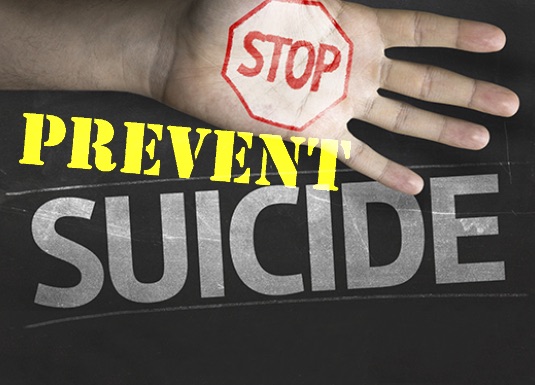After cancer and heart disease, suicide accounts for more years of life lost than any other cause of death. People of all ages, genders and ethnicities can be at risk for suicide. Suicide is a last-ditch attempt to break free from the suffering that has become unbearable. Even though they want their pain to stop, most suicidal people are deeply conflicted about ending their own lives. They wish there was another choice to committing suicide, but they just can’t see one.
Suicide prevention begins with knowing the risk and recognizing the warning signs. Most people who commit suicide don’t want to die; they just want the hurting to stop. If you think you know someone considering suicide, don’t be afraid to talk about it and seek help. Talking about suicide openly can save a life.
[lgc_column grid=”50″ tablet_grid=”50″ mobile_grid=”100″ last=”false”]
[/lgc_column]
[lgc_column grid=”50″ tablet_grid=”50″ mobile_grid=”100″ last=”true”]Common suicide risk factors include:
- Mental illness
- Alcoholism or drug abuse
- Previous suicide attempts
- Family history of suicide
- Terminal illness or chronic pain
- Recent loss or stressful life event
- Social isolation and loneliness
[/lgc_column]
Suicide warning signs
[lgc_column grid=”50″ tablet_grid=”50″ mobile_grid=”100″ last=”false”]
- Talking, writing, or posting on social media about death, dying or suicide
- Seeking access to guns, pills, knives
- Unusual focus on death, dying and violence
- Feeling trapped-like there’s no way out
- Feeling hopeless
- Feeling worthless, guilt shame, self-hatred
- Putting personal business in order-making a will, giving away prized possessions
[/lgc_column]
[lgc_column grid=”50″ tablet_grid=”50″ mobile_grid=”100″ last=”true”]
- Unusual/unexpected visits or calls to family and friends
- Withdrawing from family, friends and society
- Increased alcohol and drug use, reckless driving, unsafe sex
- Sudden sense of calm and happiness after being extremely depressed
[/lgc_column]
In addition to the general risk factors and warning signs for suicide, both teenagers and older adults are at a high risk of suicide.
SUICIDE IN TEENS
The teenage years can be emotional and stressful. They may struggle with self-esteem issues, self-doubt, and feelings of alienation. They may face pressures to succeed and fit in.
Other risk factors for teenage suicide include:
[lgc_column grid=”50″ tablet_grid=”50″ mobile_grid=”100″ last=”false”]
- Childhood abuse
- Recent traumatic event
- Lack of a support network
- Availability of a gun
[/lgc_column]
[lgc_column grid=”50″ tablet_grid=”50″ mobile_grid=”100″ last=”true”]
- Hostile social or school environment
- Exposure to other teen suicides
- Depression
[/lgc_column]
Suicide warning signs in teens
[lgc_column grid=”50″ tablet_grid=”50″ mobile_grid=”100″ last=”false”]
- Change in eating and sleeping habits
- Withdrawal from friends, family, and regular activities
- Violent or rebellious behavior
- Drug and alcohol use
- Unusual neglect of personal appearance
[/lgc_column]
[lgc_column grid=”50″ tablet_grid=”50″ mobile_grid=”100″ last=”true”]
- Boredom, difficulty concentrating, or a decline in the quality of schoolwork
- Frequent complaints about physical symptoms, often related to emotions, such as stomach-aches, headaches, fatigue, etc.
- Not tolerating praise or rewards
[/lgc_column]
SUICIDE IN THE ELDERLY
The highest suicide rates of any age group occur among persons aged 65 years and older. A contributing factor is depression in the elderly that is undiagnosed and untreated.
Other risk factors for suicide in the elderly include:
[lgc_column grid=”50″ tablet_grid=”50″ mobile_grid=”100″ last=”false”]
- Recent death of a loved one
- Physical illness, disability, or pain
- Isolation and loneliness
[/lgc_column]
[lgc_column grid=”50″ tablet_grid=”50″ mobile_grid=”100″ last=”true”]
- Major life changes, such as retirement
- Loss of independence
- Loss of sense of purpose
[/lgc_column]
Suicide warning signs in older adults
Additional warning signs that an elderly person may be contemplating suicide:
[lgc_column grid=”50″ tablet_grid=”50″ mobile_grid=”100″ last=”false”]
- Reading material about death and suicide
- Disruption of sleep patterns
- Increased alcohol or prescription drug use
- Failure to take care of self or follow medical orders
[/lgc_column]
[lgc_column grid=”50″ tablet_grid=”50″ mobile_grid=”100″ last=”true”]
- Stockpiling medications
- Sudden interest in firearms
- Social withdrawal or elaborate good-byes
- Rush to complete or revise a will
[/lgc_column]
Take any suicidal talk or behavior seriously. It’s not just a warning sign that the person is thinking about suicide—it’s a cry for help.
If you or someone you know is in a suicidal crisis call 1-800-273-TALK (8255).
References: American Foundation for Suicide Prevention (afsp.org), National Suicide Prevention Lifeline (suicidepreventiolifeline.org) Helpquide.org

